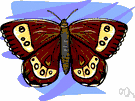ocellus
(redirected from ocellar)Also found in: Thesaurus, Medical, Encyclopedia.
o·cel·lus
(ō-sĕl′əs)n. pl. o·cel·li (ō-sĕl′ī′)
1. A simple eye, found in many invertebrates, consisting of a number of sensory cells and often a single lens.
2. A marking that resembles an eye, as on the tail feathers of a male peacock; an eyespot.
o·cel′lar (ō-sĕl′ər) adj.
American Heritage® Dictionary of the English Language, Fifth Edition. Copyright © 2016 by Houghton Mifflin Harcourt Publishing Company. Published by Houghton Mifflin Harcourt Publishing Company. All rights reserved.
ocellus
(ɒˈsɛləs)n, pl -li (-laɪ)
1. (Zoology) the simple eye of insects and some other invertebrates, consisting basically of light-sensitive cells
2. (Biology) any eyelike marking in animals, such as the eyespot on the tail feather of a peacock
3. (Botany) botany
a. an enlarged discoloured cell in a leaf
b. a swelling on the sporangium of certain fungi
[C19: via New Latin from Latin: small eye, from oculus eye]
oˈcellar adj
ocellate, ocellated adj
ˌocelˈlation n
Collins English Dictionary – Complete and Unabridged, 12th Edition 2014 © HarperCollins Publishers 1991, 1994, 1998, 2000, 2003, 2006, 2007, 2009, 2011, 2014
o•cel•lus
(oʊˈsɛl əs)n., pl. o•cel•li (oʊˈsɛl aɪ)
1. the simple eye of many invertebrates, consisting of retinal cells, pigments, and nerve fibers.
2. an eyelike spot, as on a peacock feather.
o•cel′lar, adj.
oc•el•lat•ed (ˈɒs əˌleɪ tɪd, oʊˈsɛl eɪ tɪd) oc•el•late (ˈɒs əˌleɪt, oʊˈsɛl ɪt, -eɪt) adj.
Random House Kernerman Webster's College Dictionary, © 2010 K Dictionaries Ltd. Copyright 2005, 1997, 1991 by Random House, Inc. All rights reserved.
o·cel·lus
(ō-sĕl′əs) Plural ocelli (ō-sĕl′ī′)
1. A small, simple eye or eyespot, found in many invertebrates.
2. A marking that resembles an eye, as on the wings of some butterflies.
The American Heritage® Student Science Dictionary, Second Edition. Copyright © 2014 by Houghton Mifflin Harcourt Publishing Company. Published by Houghton Mifflin Harcourt Publishing Company. All rights reserved.
ThesaurusAntonymsRelated WordsSynonymsLegend:
Switch to new thesaurus
| Noun | 1. | ocellus - an eye having a single lens ommatidium - any of the numerous small cone-shaped eyes that make up the compound eyes of some arthropods |
| 2. |  ocellus - an eyelike marking (as on the wings of some butterflies); usually a spot of color inside a ring of another color ocellus - an eyelike marking (as on the wings of some butterflies); usually a spot of color inside a ring of another colormarking - a pattern of marks |
Based on WordNet 3.0, Farlex clipart collection. © 2003-2012 Princeton University, Farlex Inc.
Translations